Original Author: Daniel Li, CoinVoice
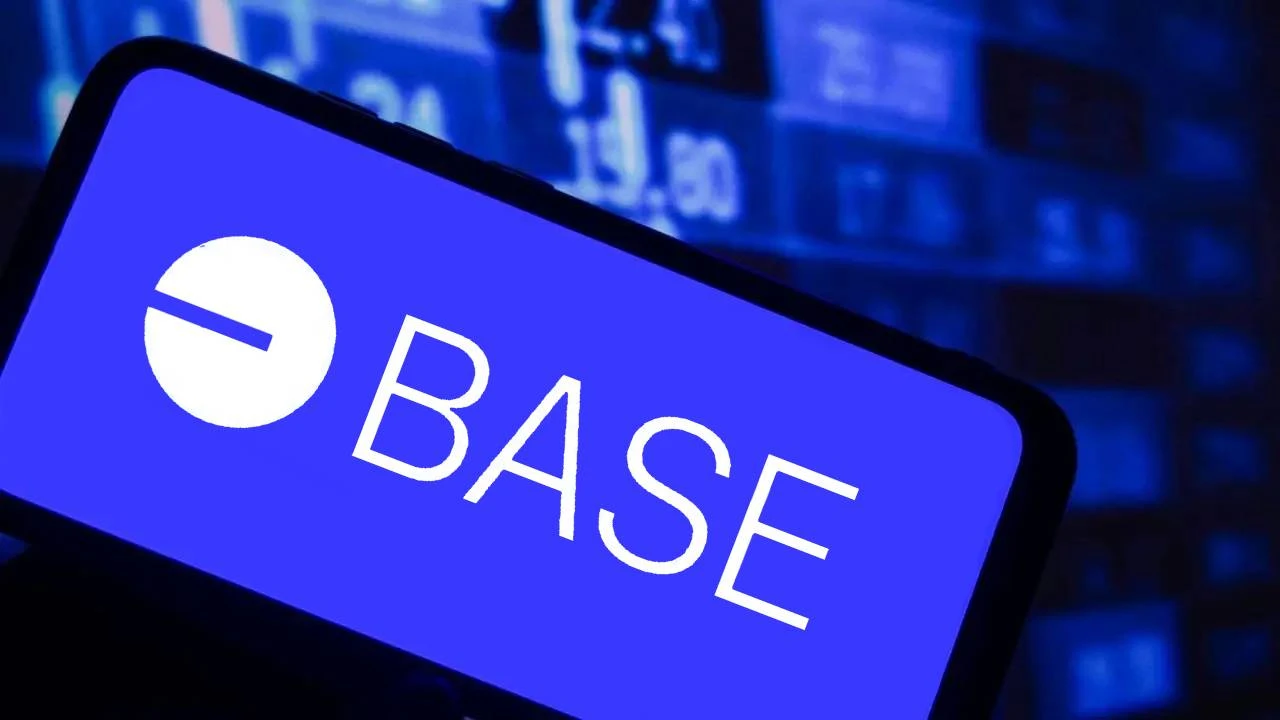
Under the narrative resonance of the Cancun upgrade and BTC halving, L2 has become the next industry hotspot and a mainstream view in the crypto market. Against this backdrop, several well-known L2 public chains have recently announced the deployment of their mainnets, aiming to quickly seize the market as the bull market approaches. Among these numerous L2 projects, the L2 public chain Base, built by Coinbase based on the OP Stack module, has recently attracted a lot of attention.
Base's popularity stems from a meme coin called BALD recently released on its chain, which saw a price increase of over a thousandfold in a single day and surpassed a market value of over 100 million USD in just 2 days, with the liquidity pool size exceeding 25 million USD. The frenzy around BALD has drawn significant attention to Base public chain, which has already begun running its mainnet and is expected to be officially released to the public in early August.
BALD's "exit" brings doubts to Base public chain
The rapid rise of the BALD token and subsequent drastic fluctuations have sparked heated discussions and doubts within the community. According to trend charts, the BALD token quickly surged to a historical high of 0.09386 USD on the first day of trading, representing an astonishing 384.88% increase from its lowest point. However, after quickly reaching its peak, the price of the BALD token began to plummet, causing significant losses for many investors.
The fluctuation in the price of the BALD token is closely related to large capital outflows. Since the Base mainnet has not been officially released to the public, the BALD tokens deployed on the Base network can currently only flow in and not out. However, this restriction only applies to ordinary investors, as "BaldBaseBald," the deployer of BALD, still has the right to sell the tokens at this time.
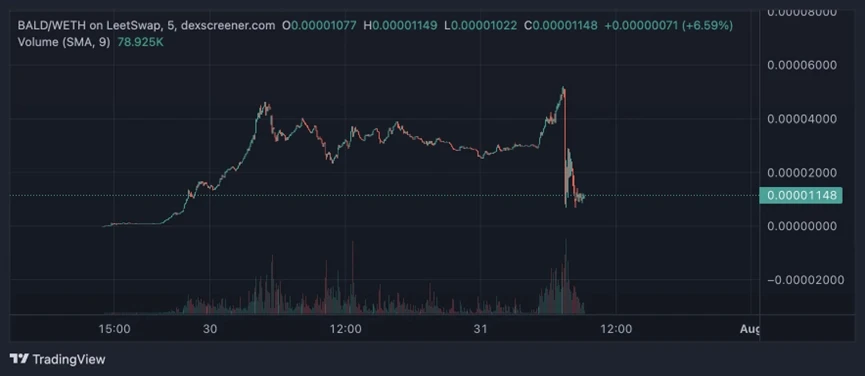
It is reported that when the BALD token reached its historical high price, BaldBaseBald withdrew over 10,500 ETH worth nearly 20 million USD from the BALD liquidity pool. This action had a significant impact on the liquidity of the BALD token pool, leading to a substantial price drop, with the maximum decline reaching 80%. Meanwhile, BaldBaseBald profited approximately 5.9 million USD from this, with almost all of the profits coming from later investors.
The operation of the BALD token is extremely similar to the basic principles of a honeypot protocol. In this strategy, token creators typically hold a large number of tokens in advance and then use their funds to drive up the token price. When ordinary investors see the price rise, they usually follow the market sentiment and buy a large amount of tokens, further driving up the price. At this point, the token creators seize the opportunity to sell their held tokens, making huge profits, while ordinary investors, unable to sell, are left trapped and suffer losses.
As for whether BALD is a "honeypot," it cannot be determined at this time. Only when the Base mainnet is officially opened to the public and ordinary users still cannot withdraw can a conclusion be drawn. However, based on the current situation, BALD is likely to cool down. The deployer's premature exploitation of positions has already scared off subsequent investors who still wanted to enter the market. The rush for quick profits by the BALD project team has also made it the shortest-lived meme coin in history. However, some have questioned whether BALD may just be a pawn, and the true strategist may be Coinbase.
Some investors have pointed out that the meaning of "bald" in BALD easily brings to mind Brian Armstrong, the CEO of Coinbase, who is known for his bald image. In addition, the deployer of the BALD token holds a large amount of cbETH, leading to speculation that BALD may have been created by personnel related to Coinbase. Although these speculations were later proven to be false, the behavior of BALD has indeed had an impact on the liquidity of the Base public chain. With the "exit" of the BALD deployer, the total value locked (TVL) of Base has sharply declined from a peak of 41.2 million USD to the current 9.54 million USD, a drop of 76.84%.
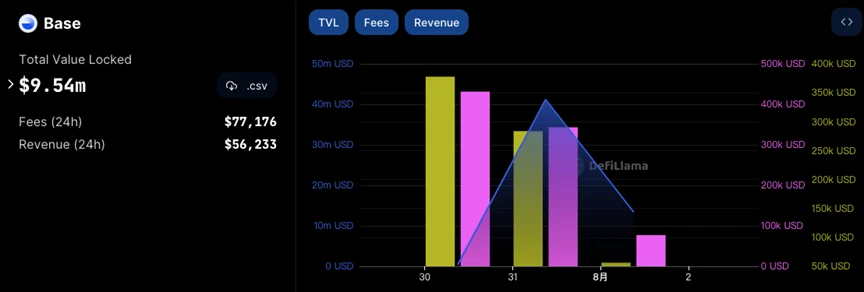
However, for the Base public chain, the impact of Bald as a meme coin is very limited. When the myth of a new meme coin's sudden wealth appears again, investors will quickly chase the next hot trend. In the long bear market, investors cherish any opportunity that may bring huge wealth. Meme coins are also used to attract market attention for most newly deployed public chains, and even some established public chains. For example, the first meme coin in the Arbitrum ecosystem, AIDOGE, once brought new vitality to the Arbitrum ecosystem and combined the current popular elements of AI+Arb+Doge to create hype, further fueling market FOMO and opening up new narrative gameplay.
In choosing a meme coin as a marketing tactic, Base public chain did nothing wrong, but erred in choosing a bad teammate. Setting aside Bald, returning to the public chain itself, Base, as an L2 public chain jointly built by Coinbase and OP, has strong capabilities. Most investors still hold an optimistic view of the future development of the Base public chain. The meme coin at the moment is just an attention-grabbing strategy, and when Base officially releases and launches truly valuable projects in August, that's when Base will truly take off. At that time, we will be able to see the true potential of the Base public chain.
Base: The Headquarters of Coinbase's On-chain Products
As the largest cryptocurrency exchange in the United States, Coinbase has been evolving towards creating an open financial system. Over the past decade, Coinbase has established protocols, built exchanges, and created popular DApps. It has now reached the final stage of its ultimate goal, which is to build an open on-chain financial system, bringing over 1 billion users into the global crypto economy.
Base public chain, as an important part of Coinbase's efforts to build a global open financial system, has been attracting high attention since it began testing in February this year. On one hand, Base, as an L2 public chain built by Coinbase based on the OP Stack module, has certain advantages in terms of performance and strengths compared to existing L2 public chains. On the other hand, backed by the largest cryptocurrency exchange in the United States, Coinbase, with over 100 million mature crypto users and a strong capital of 20 billion USD, Base has more market competitiveness compared to other L2 public chains.
As the headquarters of Coinbase's on-chain products, Base will become an open ecosystem that allows anyone to participate in building. This makes Base very developer-friendly. Developers can securely and cost-effectively build decentralized applications on Base. In the future, Base will also become one of the best places for on-chain development.
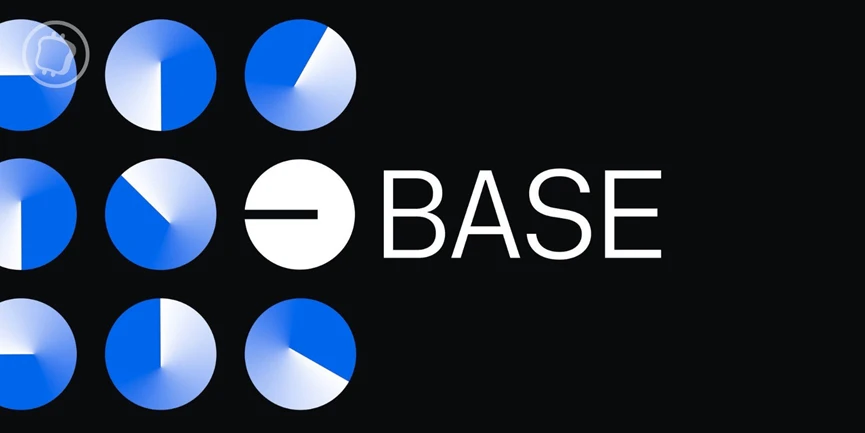
Advantages of Base:
First, Base public chain provides the security and scalability needed for decentralized applications. As one of Ethereum's scaling solutions, Base public chain utilizes Ethereum's underlying security and Coinbase's best practices to provide developers with a secure and reliable development environment, allowing them to confidently develop on Base.
Second, authorized by Coinbase, Base public chain can easily build decentralized applications that can access Coinbase products, users, and tools. This means developers can leverage Coinbase's powerful ecosystem to serve over 1.1 billion verified users and access 80 billion USD in assets on Coinbase's platform.
Third, Base public chain is powerful and cost-effective. It provides full EVM-equivalent functionality at extremely low cost and is committed to driving the development of the developer platform. Developers can use simple developer APIs for account abstraction in their decentralized applications, set up gas-free transactions, and securely build multi-chain applications through easy-to-use bridges.
Finally, Base public chain is open-source. Base aims to be decentralized, permissionless, and open to anyone who wants to create a standard, modular, and rollup-agnostic superchain powered by Optimism. As core developers of the open-source OP Stack, Base will join Optimism and work to create a thriving community composed of other developers.
Some future ecological projects worth paying attention to for Base
The mainnet of the Base public chain is currently open to developers in advance and is expected to be officially open to the public in early August. In addition to the market attention brought by the BALD token, there are actually many other projects on the Base chain that are worth paying attention to. Let's take a look at these projects together.
1. DackieSwap
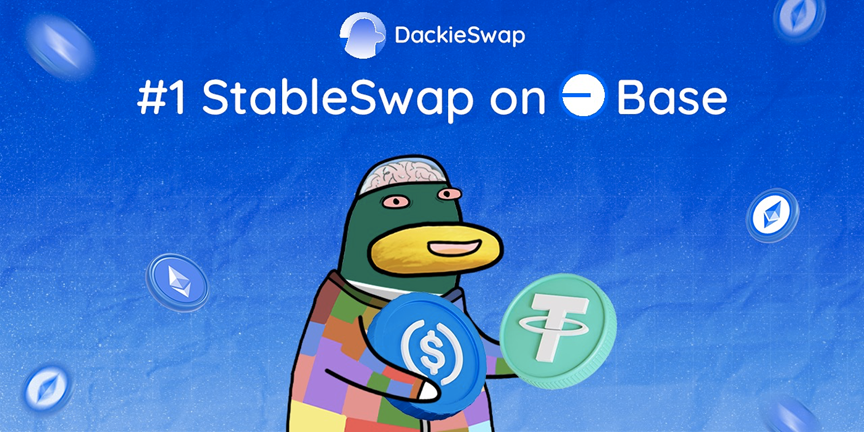
DackieSwap is the first native yield-generating decentralized exchange (DEX) on the Base public chain, a digital asset market where users can trade. DackieSwap adopts an automated market maker (AMM) model, allowing users to trade in liquidity pools. If you provide liquidity, you can receive a portion of the exchange's trading fees. Currently, DackieSwap's liquidity has reached 730 million USD, with a trading volume of 42 million USD, making it a shining gem on the Base public chain.
DackieSwap's most important feature is its StableSwap function, which is a fork of the Curve Finance protocol. It uses an algorithm to allow users to obtain the best trading path, making full use of existing liquidity pools. Unlike other DEXs, DackieSwap is committed to providing personalized, sustainable, and flexible liquidity to better meet the needs of users. Its goal is to provide users with a trading experience that is registration-free and hassle-free, helping them earn passive income through cryptocurrencies and discover early ecological opportunities. Additionally, DackieSwap is dedicated to protecting user privacy and security, using an anonymized management mode. If you are looking for a cryptocurrency exchange that is secure, efficient, does not require cumbersome operations, and can protect personal privacy well, then DackieSwap is a good choice.
2. Perennial

Perennial is a decentralized finance (DeFi) derivatives protocol designed to provide traders with price exposure, leverage exposure, and opportunities for liquidity providers to earn fees. The protocol uses an automated market maker (AMM) with concentrated liquidity, allowing traders to obtain leverage exposure from different price sources by depositing collateral, without the need to find counterparties or bear the risk of price fluctuations. At the same time, liquidity providers can provide funds in the protocol and earn fees by accepting trades from traders. In Perennial, the loser pays the winner, and the protocol automatically settles, making the trading process more efficient and trustless.
Perennial's design philosophy is based on the minimalism and unbiased design of protocols such as Uniswap V3 and Compound III, empowering market participants to make decisions on market structure and design. This allows Perennial to meet the needs of various users, including novices, complex traders, and liquidity providers. Unlike traditional derivatives trading platforms, Perennial provides a more flexible and secure trading method through the use of open protocols and decentralized market structures. Additionally, Perennial is a permissionless market creation, integration, and composition protocol, allowing users and developers to freely use it as a building block to create their own financial products and tools.
3. MES Protocol
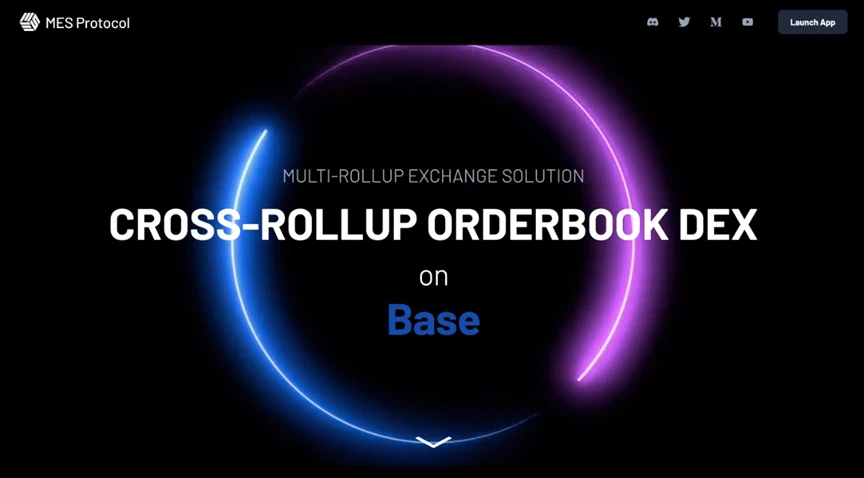
MES (Multi-rollup Exchange Solutions) is a spot trading DEX on the Base public chain, using a cross-rollup order book to provide a cross-rollup interoperable exchange solution for users. MES aims to achieve asset and data exchange across different rollups, integrating token exchange order books and seamless asset transfers between networks.
In the MES Protocol, the cross-rollup mode is one of its core features. It provides a unified order book, enabling asset and data exchange across multiple rollups. When the cross-rollup mode is activated, liquidity across rollups is aggregated, allowing users to seamlessly interact with and utilize liquidity from multiple chains, effectively closing orders and reducing slippage. The MES protocol uses Rollup technology to reduce the computational requirements for executing trades, thereby reducing gas consumption. It leverages Ethereum's security, as well as Rollup's scalability and efficiency, to provide users with an efficient, secure, and low-cost trading experience.
Compared to other DEXs deployed on different rollups, MES Protocol has stronger cross-rollup interoperability. It brings the intuitive trading experience and various trading functions of centralized exchanges to decentralized exchanges, allowing users to comfortably trade digital assets. Additionally, it offers lower trading costs and faster transaction speeds, enabling users to better utilize assets and data to achieve higher value. Furthermore, the MES protocol provides L1 security and L2 Rollup's high throughput and low cost, offering users a better way to utilize assets and data.
4. Backed
Backed aims to connect stocks with decentralized finance (DeFi) to expand the accessibility of financial assets. It introduces fully collateralized ERC20 tokens representing the value of popular stocks such as Tesla, Google, and Apple, which can be used throughout the DeFi ecosystem.
Backed Tokens are tokens issued by the Backed project, representing the value of real-world assets such as stocks. Each Backed Token is a fully collateralized tracking certificate unit, tracking the listing value of a specific security and fully backed by that security. These tokens are fully compliant with Swiss law, freely transferable on the blockchain, and can be sold directly to qualified investors and licensed dealers through the Backed platform.
By tokenizing real-world assets, Backed Tokens provide investors with an opportunity to access real-world assets on the blockchain. These tokens can be used in the DeFi ecosystem for trading, lending, and other financial activities. On the Backed platform, stocks and other real-world assets are transformed into tokens, allowing for more flexible trading and holding, thereby expanding the accessibility of financial assets.
In summary
Looking at the ecological projects of the Base public chain, it can be seen that there are indeed very promising and prospective projects on the Base chain, but the Base public chain has not yet been officially announced to the public, and these projects have not yet started to exert their efforts. The design philosophy of the Base public chain is to "allow anyone to create and run their own distributed applications," which gives all developers equal opportunities for development, but also provides a good opportunity for speculators. Therefore, we need to take a more prudent approach to the various tokens and applications running on the Base public chain, not to be blinded by surface attractiveness, but to carefully assess the feasibility and risks of the projects. Only in this way can we better utilize the advantages of the Base public chain.
免责声明:本文章仅代表作者个人观点,不代表本平台的立场和观点。本文章仅供信息分享,不构成对任何人的任何投资建议。用户与作者之间的任何争议,与本平台无关。如网页中刊载的文章或图片涉及侵权,请提供相关的权利证明和身份证明发送邮件到support@aicoin.com,本平台相关工作人员将会进行核查。




